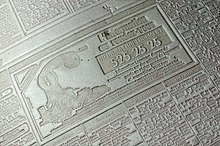Lottinoplasty
Lottinoplasty , also called lottinoplastique , is a method of creating molds for casts of ancient antiquities. It was developed in the 19th century by the archaeologist Pierre-Victorien Lottin .
Emergence
As Lottin in winter 1843, the cuneiform to the castle of Van saw, he tried by the cuneiform imitation copy but had to retire because of persistent bad weather. Then he remembered experiments that he had made ten years earlier on an archaeological trip through Italy with casting techniques and obtained the necessary ingredients in Baghdad . Then he developed the lottinoplasty .
method
To protect the object from which a cast is to be taken, it is first moistened with a sponge or smeared with linseed oil . Then several sheets of coarse paper are soaked in a flat bowl and then placed on the object of which you want to make a cast. Then a thick layer of paper mache is applied over it and brushed off to avoid wrinkles. Then the object coated in this way is moistened again and coated with paste that has been enriched with a little aluminum sulfate . Then another layer of paper is loosely applied. Finally, the structure is coated with hot gelatine or warm glue. After the applied mass has dried through, it is carefully removed. The paper mache form is then coated with lard or sesame oil and placed near a fire or in the hot sun. Shapes of larger objects can simply be sawed through for easier transport. Then the form is coated with a hot mixture of oil, wax and turpentine essence and baked in an oven for half an hour at 80 ° - 100 ° C. Then you can pour plaster of paris into the molds .
Effects
The photographer and archaeologist Léon-Eugène Méhédin (1828-1905) visited Lottin in 1854 in his house in Menneval and then applied the Lottinoplasty on the expeditions that led him to Egypt and Mexico in 1860 and 1861 . The lottinoplasties made in Mexico were exhibited in the Musée de l'Homme .
Lottinoplasty made the development of the flan possible. The flan is a printing matrix made of soft cardboard or rubber . And was first used in the printing machines by Hippolyte Auguste Marinoni (1823–1904).
literature
- Nicole Zapata-Aubé: Lottin de Laval . Archéologiste et Peintre Orientaliste. Association pour la Promotion de la Culture, Bernay 1997. (French)
- Pierre-Victorien Lottin: Manuel Complet De Lottinoplastique . 1857 ( online ).
Individual evidence
- ↑ Zapata-Aubé p. 32
- ↑ Zapata-Aubé pp. 35f + 40
- ↑ Manuel Complet De Lottinoplastique
- ↑ Zapata-Aubé p. 50
- ^ Victor Le Fort: Lottin de Laval, le père du flan . In: La Revue illustrée du Calvados . Imprimerie Morière, Lisieux April 1914 ( online [accessed 11 August 2011]).

